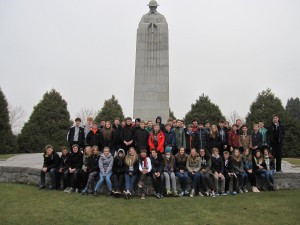
Wellington School Year 9 students spent a thoughtful weekend exploring the battlefields of Belgium and France. A group of over 60 students and staff travelled to Ypres on a History field trip, spent time at museums, cemeteries and battle sites and tracked lost relatives.
At the Menin Gate, where 55,000 soldiers whose bodies were never found are commemorated, three pupils laid a wreath from the school and listened to the evocative Last Post sound across the town.
At Poperinge, students were shocked to see the death cells and site of British Army executions – including a boy soldier shot at dawn for desertion, and listened to a reading of the poem “The Coward” by Rudyard Kipling. The Passchendaele Museum provided an excellent source of information and the scale of the Front Line at Ypres was demonstrated by the knowledgeable guide.
At the largest British cemetery, Tyne Cot, Year 9 bugler Tim Kilbey played the Last Post and all the other visitors stood silent in tribute to those killed in action.
The party moved on to the Brooding Soldier Memorial at Vancouver Corner, the site of the first gas attack where Wilfrid Owen’s poem Dulce et Decorum Est was read to the solemn students. Throughout the trip, many war poems were read on the sites they were written, to encapsulate the atmosphere of the place and the mood of the writer,
“It is important for our students to appreciate the scale of the war and all the reverberations,” commented History teacher, Linda Burton who led the trip. “The Year 9 pupils are studying WW1 across all subjects, so we look at art, literature and history as well as some of the political and economic factors. They must respect the sites we visit and understand the sacrifices that were made for us all. We don’t just stand and look, we try to get under the skin of what happened, why, what could have been done differently and what these men were feeling.”
At Sanctuary Wood, the students were able to explore the original trenches and tunnels and feel the claustrophobia soldiers would have experienced. This is especially poignant as a previous Headmaster of Wellington School’s nephew was killed near Sanctuary Wood, so planted the school’s own version of the wood and built the Memorial Chapel to commemorate those students lost in the war.
At the Thiepval Memorial on the Somme, where 72,000 missing British and South African soldiers are commemorated, the Last Post was again sounded by bugler Tim Kilbey, and students found inscriptions to their lost relatives.
All of the students contemplated the last few hours of the Accrington Pals from the East Lancashire Regiment before they went over the top at Serre, and then re-enacted their walk toward the enemy machine guns, falling as they fell just yards from their own trenches.
At the Essex Farm field hospital where the young Canadian doctor John McCrae wrote “In Flanders Field”, students listened to that poem whilst standing at the grave of the youngest boy to be killed in the war – aged 15.
“Our students have had a full and thorough immersion into the life of the British Tommy at the Western Front. Even though our society has more media access to death, war and killing than ever before, it is crucial that our young people don’t become blasé and never lose the sense of horror that the war brought and which must remain in our minds. It is not just about history, it is about the present and the future”, concluded Linda Burton.